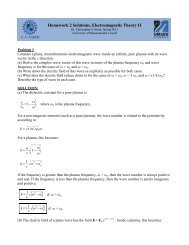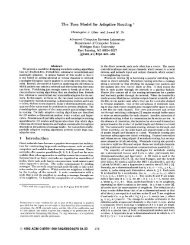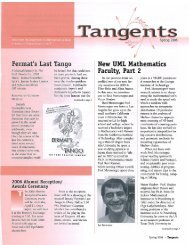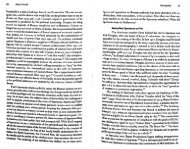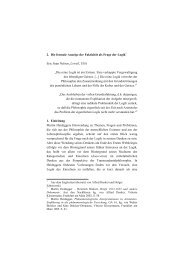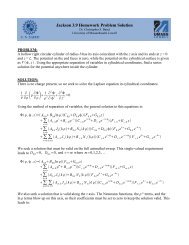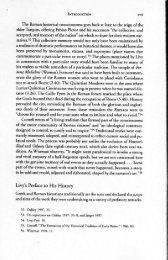167 Paul John Frandsen EGYPTIAN IMPERIALISM* By way of ...
167 Paul John Frandsen EGYPTIAN IMPERIALISM* By way of ...
167 Paul John Frandsen EGYPTIAN IMPERIALISM* By way of ...
You also want an ePaper? Increase the reach of your titles
YUMPU automatically turns print PDFs into web optimized ePapers that Google loves.
168 169<br />
Kingdom is generally recognized, a new case has been made out recently<br />
for a kind <strong>of</strong> hold over Syria and Palestine by the pharaos <strong>of</strong> the 12th dynasty,"<br />
Having enumerated "the most striking facts"3 Posener concludes<br />
that "there emerges the impression <strong>of</strong> domination by the pharaohs, uneven<br />
and interrupted, no doubt, but on the whole vigorous. Its precise<br />
nature still eludes US".4<br />
Let us briefly look at his arguments. "The sources at our disposal are<br />
evasive", he says, "and do not permit us to settle the question"! (whether<br />
there was a political domination/empire).<br />
He shows that the use <strong>of</strong> the-Execration Texts "as a source for political<br />
history is very hazardous", though the texts' omission - among the potential<br />
enemies <strong>of</strong> Egypt - <strong>of</strong> precisely those towns "in which (...) the<br />
presence <strong>of</strong> Egyptians made itself especially strongly felt" "may be significant".6<br />
There remains, then, the actual Egyptian material found in these<br />
places, first and foremost statues <strong>of</strong> Middle Kingdom <strong>of</strong>ficials found in<br />
Megiddo, Ugarit, etc.<br />
Arguing by analogy with a similar group <strong>of</strong> statues <strong>of</strong> Middle Kingdom<br />
<strong>of</strong>ficials found at Kerma in Nubia and by reference to the other inconclusive<br />
material he arrives at the conclusion quoted a moment ago."<br />
To put it bluntly, this is an instance <strong>of</strong> the typical dagger-handle <strong>way</strong><br />
<strong>of</strong> reasoning, and, as it happens, HeIck has demonstrated beyond doubt<br />
that both the Nubian and the Asiatic material have been found in archaeological<br />
contexts that cannot be dated earlier than the Hyksos period.f<br />
Consequently, the Egyptian domination over Syria and Palestine must be<br />
regarded as a red herring.<br />
The Egyptian occupation <strong>of</strong> Lower Nubia during the Middle Kingdom<br />
is as certain as the purpose and content <strong>of</strong> this domination is disputed''<br />
and in what follows I shall therefore confine myself to the New Kingdom,<br />
the period <strong>of</strong> the Empire, as it is called in all textbooks. Within this span<br />
<strong>of</strong> time the bulk <strong>of</strong> material drawn upon will be from the 18th dynasty,<br />
that is - roughly speaking - from 1500-1300 B.C.<br />
During this period Egyptian expansion was directed towards Asia and<br />
Nubia, the two traditional foci <strong>of</strong> the country's foreign policy. Scholars<br />
usually refer to the outcome <strong>of</strong> this process in terms <strong>of</strong> occupation, but,<br />
as will be seen, the measures adopted by the Egyptians in the two areas <br />
their scope and execution - were in certain basic respects so different,<br />
that the grouping <strong>of</strong> them under such a heading is hardly justifiable. In<br />
terms <strong>of</strong> territorial expansion the peak was reached in the reign <strong>of</strong> Thutmosis<br />
III who succeeded in extending the southern frontier all the <strong>way</strong><br />
down to the 4th cataract, while parts <strong>of</strong> Syria and Palestine were brought<br />
into some state <strong>of</strong> dependency on Egypt. In both areas the form and content<br />
<strong>of</strong> their relationship with Egypt were subject to modification and<br />
development, but in that I am not immediately concerned with the history<br />
<strong>of</strong> the individual components <strong>of</strong> this relationship as such, the following<br />
survey <strong>of</strong> what I consider the most salient features will present a state <strong>of</strong><br />
affairs, which - as a whole - may have existed only at a given point<br />
during the New Kingdom, or indeed may not have existed at all. This<br />
procedure, <strong>of</strong> course, raises at least one very important problem which<br />
will be discussed later.<br />
Let us now tum our attention to Nubia, where the Egyptians managed<br />
to accomplish an almost perfect Egyptianization. 10<br />
At the political and administrative level the expansion meant the introduction<br />
<strong>of</strong> the Egyptian administrative technique. The country was<br />
divided into two regions: Wawat, embracing lower Nubia down to Semna,<br />
immediately south <strong>of</strong> the second cataract, and Kush, the deep south.<br />
Monuments and especially prosopographical analyses show that the<br />
government <strong>of</strong> Nubia was modelled on that <strong>of</strong> Egypt. At its head was the<br />
Viceroy, who was responsible only to the king on an equal footing with<br />
the vizier. And again corresponding to the organizational role <strong>of</strong> the<br />
viziers <strong>of</strong> Upper and Lower Egypt, Wawat and Kush were then administered<br />
by two deputies, and both regions were subdivided into settlements<br />
or administrative districts, each under the control <strong>of</strong> a mayor. The<br />
government comprised the usual departments, witness such titles as Overseer<br />
<strong>of</strong> the Treasury, Overseer <strong>of</strong> Granaries, etc.<br />
At all levels <strong>of</strong> administration the majority <strong>of</strong> the <strong>of</strong>ficials seem to have<br />
been Egyptians, but local chiefs even holding important <strong>of</strong>fices were by<br />
no means rare. Like in Syria and Palestine the Egyptians took great pains<br />
to ensure their loyalty. To this end the most effective means was the<br />
practise <strong>of</strong> taking the sons <strong>of</strong> the indigenous rulers as hostages to Egypt,<br />
where the education at the court <strong>of</strong> Pharaoh was so successful that,<br />
allegedly, they forgot their own language.'! However, in that the aim <strong>of</strong><br />
Egyptian policy in the two areas was not the same, the Nubian youths<br />
were apparently brought up as potential members <strong>of</strong> the Egyptian ruling<br />
class.P i.e, having "job possibilities" in Nubia as well as Egypt. In support<br />
<strong>of</strong> this contention I should like to draw attention, first to the well known<br />
fact that these "children <strong>of</strong> the royal training school" 12 a not only had<br />
their native names replaced by an Egyptian one, but, more significantly,<br />
had their tombs cut in a wholly Egyptian style. Already in the early part<br />
<strong>of</strong> the 18th dynasty we find tombs which are completely indistinguishable<br />
from those <strong>of</strong> true Egyptian <strong>of</strong>ficials.P The second point actually needs<br />
further elaboration before it can find general acceptance, but it cannot be<br />
denied that, as from the reign <strong>of</strong> Amenophis II, men <strong>of</strong> Nubian extraction<br />
figure conspicuously among the most trusted <strong>of</strong>ficials <strong>of</strong> Pharaoh. Thus<br />
the tutor <strong>of</strong> Tuthmosis IV - whose name shows him to be a Nubian (or



